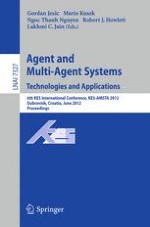This book constitutes the refereed proceedings of the 6th KES International Conference on Agent and Multi-Agent Systems, KES-AMSTA 2012, held in Dubrovnik, Croatia, in June 2012.
The conference attracted a substantial number of researchers and practitioners from all over the world who submitted their papers for ten main tracks covering the methodology and applications of agent and multi-agent systems, one workshop (TRUMAS 2012) and five special sessions on specific topics within the field. The 66 revised papers presented were carefully reviewed and selected for inclusion in the book. The papers are organized in topical sections on virtual organizations, knowledge and learning agents, intelligent workflow, cloud computing and intelligent systems, self-organization, ICT-based alternative and augmentative communication, multi-agent systems, mental and holonic models, assessment methodologies in multi-agent and other paradigms, business processing agents, Trumas 2012 (first international workshop), conversational agents and agent teams, digital economy, and multi-agent systems in distributed environments.
